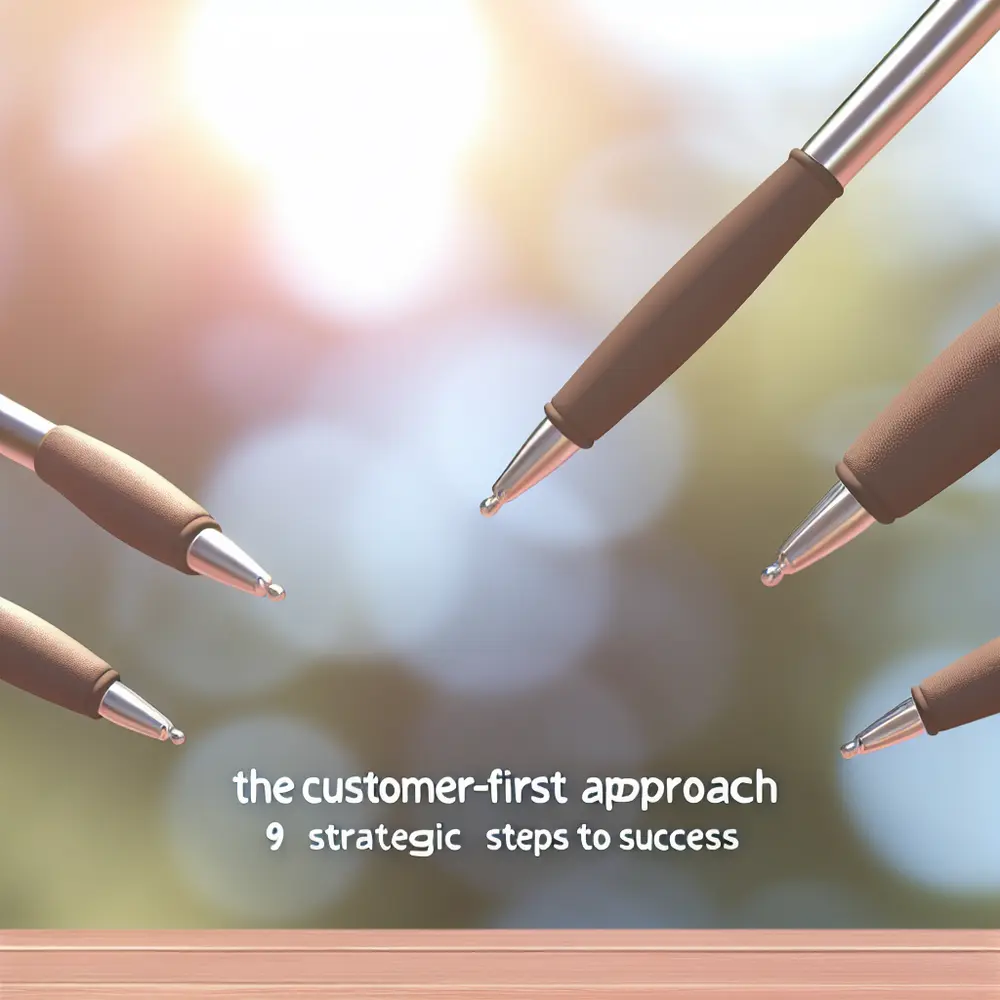Introduction
Are you struggling to connect with your customers and meet their expectations? In today’s competitive landscape, prioritizing customer needs is essential for long-term success. A customer-first approach enables companies to build loyalty and enhance customer experiences, driving growth and profitability. Ignoring this shift could lead to missed opportunities.
As consumers become more discerning, putting their needs first becomes paramount. Companies that fail to adapt risk falling behind their competitors. Embracing a customer-centric strategy allows you to forge deeper relationships, understand pain points, and offer tailored solutions. This leads to increased satisfaction and repeat business.
In this article, you will discover the importance of adopting a customer-first approach, its benefits, and actionable strategies to implement it within your organization. Transforming the way you do business can create a lasting impact on your bottom line and strengthen your position in the market.
Understanding the Customer-First Approach
The customer-first approach prioritizes customer needs in every aspect of a business. By implementing this strategy, organizations enhance customer experiences (CX) and foster lasting relationships. This shift turns attention from merely selling products to truly understanding customer pain points.
Take, for example, the “HealthPlus Clinic.” By actively listening to patient feedback through surveys and interviews, HealthPlus identified key concerns regarding appointment scheduling. As a result, they streamlined their appointment system, increasing patient satisfaction by 25% within three months.
A core component of this approach is integrating customer service across all channels. Omnichannel support allows businesses to engage seamlessly with customers. The online retailer “ShopSmart” deployed an omnichannel system, which led to a 30% boost in customer engagement and a 20% increase in return customers.
Personalization is also vital. By utilizing customer data, companies can craft tailored experiences that resonate with consumers. A study showed businesses that personalize customer interactions see a 10% increase in sales. The company “GadgetWorld” adopted this strategy and boosted their sales by 40% following personalized recommendations.
Continuous improvement based on customer feedback is essential. Monitoring key performance indicators (KPIs) like customer satisfaction enables businesses to adapt. As “FastTrack Logistics” refined their delivery processes based on customer insights, they saw a reduction in delivery time by 15%, leading to higher customer retention rates.
The Importance of a Customer-Centric Strategy
Emphasizing a customer-focused strategy leads to sustained business success. Companies that prioritize customer needs often outperform competitors in market share and profitability. Tailoring offerings to target audiences fosters strong relationships and loyalty.
The “Foodie Delight” restaurant began prioritizing customer experience and saw a 35% increase in patronage within six months. By actively listening to customer feedback, they adapted their menu based on preferences, leading to enhanced satisfaction and repeat visits.
In fast-paced markets, focusing on CX is essential. Organizations that anticipate customer needs enjoy improved engagement and retention rates. Research indicates that businesses with robust CX strategies can achieve up to 80% higher customer retention.
Integrating a customer-first approach into company culture is vital. It requires training employees at every level to prioritize customer service. By aligning company objectives with customer satisfaction, organizations position themselves to reach strategic goals more effectively.
Data analysis is critical for establishing a customer-centric strategy. Understanding behavior patterns and preferences through data allows businesses to personalize interactions. The “Tech Solutions” firm utilized data-driven decisions and increased customer lifetime value (CLV) by 25% in just one year.
Key Benefits of a Customer-First Approach for Business Success
Implementing a customer-first strategy is essential for sustainable growth and enhanced customer satisfaction. Companies prioritizing their customers typically outperform competitors in numerous ways. This approach fosters deeper relationships, leading to higher loyalty and retention rates.
Consider the case of “Fashion Hub,” a retail company that implemented a customer-first strategy and experienced a 50% improvement in customer retention. By responding promptly to feedback and refining their product offerings, they encouraged positive word-of-mouth marketing.
A well-executed CX strategy ensures seamless interactions across touchpoints. “Home Essentials” streamlined their customer experience and noticed a 30% increase in repeat purchases, creating a consistent revenue stream.
Empowering businesses to gather feedback enhances offerings. For instance, “Pet Care Services” utilized customer insights to refine their service model, resulting in a 20% increase in client satisfaction. This continuous refinement is crucial for staying competitive.
Moreover, fostering a collaborative culture enhances accountability. Implementing a customer-first methodology encourages teamwork. The “Transport Solutions” company reported a 15% increase in team productivity, as all employees aligned to prioritize customer needs.
9 Strategic Steps to Implementing a Customer-First Approach
Start with defining customer personas to tailor your CX strategy effectively. Gather data on demographics and preferences to create personalized experiences that resonate,” Customer Journey Mapping is key. Identify every touchpoint as customers interact with your brand. This helps pinpoint improvement opportunities.
Cross-department collaboration is vital for alignment. Conduct regular meetings to ensure every team understands its role in the customer experience. Involve your entire workforce in prioritizing customer satisfaction.
Regularly collect customer feedback using surveys and direct interactions. Responding to feedback showcases commitment to improvement. This commitment is vital for maintaining loyalty and encouraging customer advocacy.
Train your team on customer experience best practices. Investing in employee training leads to higher customer satisfaction levels, as well-prepared staff can handle inquiries efficiently and resolve issues promptly.
Empower customers through self-service options, like FAQs and chatbots. This strategy caters to preferences for quick resolutions, enhancing satisfaction. Continuous analysis of these options can lead to further improvements.
Creating an Effective CX Strategy
Develop a customer-first strategy by understanding your audience genuinely. This foundational step is critical for leveraging insights. Conduct thorough research to inform tailored offerings.
Map the customer journey to visualize touchpoints and pinpoint opportunities. Empower employees by training them to adopt a customer-first mindset and provide necessary resources for prompt responses.
Utilize omnichannel approaches for consistent communication across platforms. This integration enhances customer engagement and builds brand loyalty significantly. Aim to continuously measure the success of your CX strategy with KPIs.
Consider feedback loops that allow for ongoing adaptation and improvement. Remaining agile in response to evolving customer needs positions your brand as a leader in customer experience.
By prioritizing a customer-first approach, you can elevate your brand and reinforce loyalty while fostering deeper connections with your customer base.
Measuring Success: KPIs for a Customer-First Strategy
Identify key performance indicators (KPIs) to assess the effectiveness of your customer-first approach. One important metric is the Net Promoter Score (NPS), which indicates customer loyalty by measuring how likely they are to recommend your company.
A strong NPS suggests high customer satisfaction. Regularly tracking NPS allows you to gauge the effectiveness of your CX strategy. For instance, “Online Store XYZ” improved their NPS by 15% after implementing customer feedback systems.
Customer Satisfaction Score (CSAT) is another vital KPI that reflects satisfaction levels. Regular feedback collection helps identify strengths and areas needing improvement. For example, “Beauty Haven” increased their CSAT by 20% after addressing customer concerns promptly.
Monitor the churn rate to understand retention success. A lower churn rate indicates healthy customer loyalty. The company “Travel Luxury” tracked churn rate and, after refining their service, reduced it by 10% over six months.
Lastly, leverage a holistic dashboard consolidating multiple metrics to monitor success effectively. By utilizing an omnichannel support platform, you can streamline this process and maintain alignment with business goals.
Overcoming Challenges in Implementing a Customer-First Approach
Implementing a customer-first approach presents challenges that must be addressed. Resistance to change can hinder progress; thus, fostering a culture valuing customer feedback is essential. Communication and training can facilitate this shift.
Aligning the organization with a customer-first approach poses further challenges. Departments often operate in silos, so breaking down barriers is critical for delivering cohesive customer experiences. Encourage interdepartmental collaboration to understand customer needs better.
Data management plays a crucial role in creating tailored experiences. Invest in robust data systems to consolidate information. For example, “Fitness Tracker” utilized an omnichannel platform, improving their understanding of customer preferences.
Balancing immediate business goals with long-term customer satisfaction can conflict. Focusing on customer relationship investments is crucial for enhancing loyalty. “Green Clean” achieved a 30% increase in customer loyalty by prioritizing sustainable practices that resonate with clients.
Establish metrics for measuring customer-first effectiveness. Regularly monitor and adapt based on established KPIs, fostering a culture of continuous improvement that aligns with evolving customer expectations.
Case Studies: Brands Excelling with a Customer-First Philosophy
Zappos exemplifies customer service through a customer-first approach. They empower employees to create memorable experiences, leading to significant loyalty and repeat business. Their success showcases how prioritizing customer needs drives business growth.
Netflix effectively utilizes data analytics for personalized recommendations, creating a seamless viewing experience. High customer retention rates underscore the impact of a focused customer-centric strategy, allowing Netflix to thrive in competition.
Starbucks leverages rewards programs to enhance engagement and gather feedback. This proactive approach fosters loyalty and informs product development, reinforcing their leadership in the coffee industry.
Utilizing customer success as a core principle, HubSpot empowers users with educational resources. This strategy drives growth and establishes a reputation as a trusted partner in marketing.
Finally, Apple integrates feedback into product development. Their commitment to exceptional customer experiences secures their loyal customer base, highlighting the power of a consistent CX strategy in achieving sustained success.
The Future of Business is Customer-Centric
In a dynamic business landscape, adopting a customer-first approach is essential for long-term success. Companies prioritizing CX build trust and loyalty with clients. This strategy is no longer a trend but a requirement for prospering.
Personalization is pivotal. Businesses must deeply understand customer needs to provide tailored solutions. Collecting significant data informs interactions and offerings, translating to elevated customer experiences.
Implementing omnichannel support ensures uniform experiences across all platforms. Consistency reinforces brand identity and communicates customer value in every interaction.
Continuous measurement of customer satisfaction should be a priority for businesses. This helps inform service improvements and identify innovation opportunities, keeping companies competitive.
Finally, genuine commitment from leadership is crucial for transformation. Leaders must instill a culture that prioritizes customer needs at every organization level, a strategic imperative for facilitating sustainable growth. The future depends on recognizing customer-centricity as the key to ongoing success.
To learn more about optimizing your customer experience strategy, visit Nexloo.









